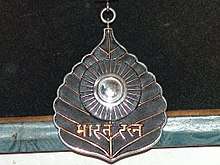Govind Ballabh Pant
Govind Ballabh Pant (10 September 1887 – 7 March 1961) was an Indian freedom fighter and one of the architects of modern India. Alongside Mahatma Gandhi, Jawaharlal Nehru and Vallabh Bhai Patel, Pant was a key figure in the movement for India's Independence and later a pivotal figure in the Indian Government. He was one of the foremost political leaders of Uttar Pradesh (then known as United Provinces) and a key player in the unsuccessful movement to establish Hindi as the national language of Indian Union.
Govind Ballabh Pant | |
|---|---|
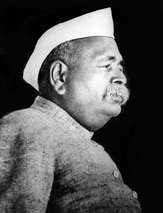 | |
| Minister of Home Affairs | |
| In office 10 January 1955 – 7 March 1961 | |
| Prime Minister | Jawaharlal Nehru |
| Preceded by | Kailash Nath Katju |
| Succeeded by | Lal Bahadur Shastri |
| 1st Chief Minister of Uttar Pradesh | |
| In office 26 January 1950 – 27 December 1954 | |
| Preceded by | Office Established |
| Succeeded by | Sampurnanand |
| 2nd Chief Minister of United Provinces | |
| In office 17 July 1937 – 2 November 1939 | |
| Preceded by | Muhammad Ahmad Said Khan Chhatari |
| Succeeded by | Vacant |
| In office 1 April 1946 – 25 January 1950 | |
| Preceded by | Vacant |
| Succeeded by | Position abolished |
| Personal details | |
| Born | 10 September 1887 Khoont, North-Western Provinces, British India (Present-day Uttarakhand, India) |
| Died | 7 March 1961 (aged 73) New Delhi, India |
| Nationality | Indian |
| Political party | Indian National Congress |
| Children | 3, including Krishna Chandra Pant |
| Residence | No. 6, Maulana Azad Road, New Delhi |
| Alma mater | Allahabad University |
| Profession | Lawyer Independence Activist |
Today, several Indian hospitals, educational institutions and foundations bear his name. Pant received India's highest civilian honour, the Bharat Ratna, in 1957.
Early life
Govind Ballabh Pant was born on 10 September 1887 in Khoont village on the slopes of Shyahi Devi hill near Almora. He was born in a Karhade Brahmin family that had migrated from the present day Western Maharashtra many generations prior to his birth.[1] His mother's name was Govindi Bai. His father Manorath Pant was a government official who was constantly on the move, and hence Govind was brought up by his maternal grandfather, Badri Dutt Joshi, an important government official locally, who played a significant part in moulding his personality and political views.[2]
Pant studied at Allahabad University and subsequently worked as a lawyer in Kashipur. Here, he began active work against the British Raj in 1914, when he helped a local parishad, or village council, in their successful challenge of coolie begar, a law requiring locals to provide free transportation of the luggage of travelling British officials. In 1921, he entered politics and was elected to the Legislative Assembly of the United Provinces of Agra and Oudh.
In the freedom struggle
Known as an extremely capable lawyer, Pant was appointed by the Congress party to initially represent Ramprasad Bismill, Ashfaqulla Khan and other revolutionaries involved in the Kakori case in the mid 1920s. In 1930, he was arrested and imprisoned for several weeks for organising a Salt March inspired by Gandhi's earlier actions. In 1933, he was arrested along with Harsh Dev Bahuguna (Gandhi of Choukot) and imprisoned for seven months for attending a session of the then-banned provincial Congress. In 1935, the ban was rescinded, and Pant joined the new Legislative Council. During the Second World War, Pant acted as the tiebreaker between Gandhi's faction, which advocated supporting the British Crown in their war effort, and Subhas Chandra Bose's faction, which advocated taking advantage of the situation to expel the British Raj by all means necessary. In 1934, the Congress ended its boycott of the legislatures and put up candidates, and Pant was elected to the Central Legislative Assembly. He became deputy leader of the Congress party in the Assembly.[3]
In 1940, Pant was arrested and imprisoned for helping organise the Satyagraha movement. In 1942 he was arrested again, this time for signing the Quit India resolution, and spent three years in Ahmednagar Fort along with other members of the Congress working committee until March 1945, at which point Jawaharlal Nehru pleaded successfully for Pant's release, on grounds of failing health.[3]
Premier of United Provinces 1937/ Chief Minister of Uttar Pradesh 1950
Pant took over as the Chief Minister of the United Provinces from 1937 to 1939.
In 1945, the British Labour government ordered new elections to the Provincial legislatures.[3] The Congress won a majority in the 1946 elections in the United Provinces and Pant was again the Premier, continuing even after India's independence in 1947.
His judicious reforms and stable governance in the Uttar Pradesh stabilised the economic condition of the most populous State of India. Among his achievements in that position was the abolition of the zamindari system. Also he passed the Hindu Code Bill and made monogamy compulsory for Hindu men and gave the Hindu women the rights of divorce and inheritance to ancestral property. Pant moved from Lucknow to New Delhi to be sworn in as Cabinet Minister without Portfolio in the Union Cabinet on 3 January 1955.
Union Home Minister of India
Pant served as Union Home Minister from 1955 to 1961.[4] Pant was appointed Minister of Home Affairs in the Union Cabinet on 10 January 1955 in New Delhi by Jawaharlal Nehru. As Home Minister, his chief achievement was the re-organisation of States along linguistic lines. He was also responsible for the establishment of Hindi as an official language of the central government and a few states.[5]
During his tenure as the Home Minister, Pant was awarded the Bharat Ratna.[6] on 26 January 1957.
Death
In 1960, he suffered a heart attack. He was treated by top doctors in India, including his friend Dr Bidhan Chandra Roy, the then Chief Minister of West Bengal. His health started deteriorating and he died on 7 March 1961 at the age of 74, from a cerebral stroke. At that time he was still in office as the Home Minister of India.
Mourning him, Dr Rajendra Prasad, the then President of India was quoted as saying,"I had known Pandit Govind Ballabh Pant since 1922 and in this long period of association it had been my privilege to receive from him not only consideration but also affection. This is no time to assess his labour and his achievements. The grief is too intense for words. I can only pray for peace to his soul and strength to those who loved and admired him".
Institutions and monuments
- Govind Ballabh Pant Social Science Institute, Allahabad
- Govind Ballabh Pant University of Agriculture and Technology, Pantnagar
- Govind Ballabh Pant Engineering College, Pauri Garhwal, Uttarakhand
- Govind Ballabh Pant Institute of technology ,Okhla New Delhi
- Govind Ballabh Pant Engineering College, Delhi
- Govind Ballabh Pant Sagar is an Artificial lake at Sonebhadra, Uttar Pradesh
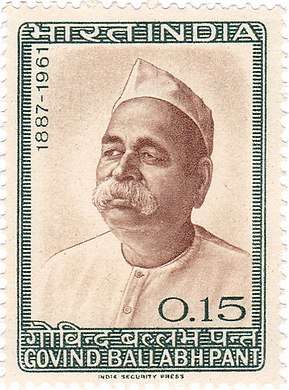 Pant on a 1965 stamp of India
Pant on a 1965 stamp of India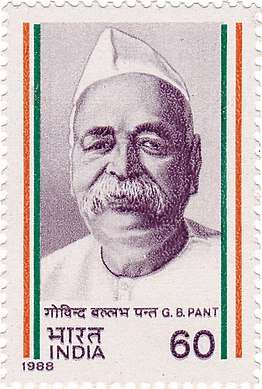 Pant on a 1988 stamp of India
Pant on a 1988 stamp of India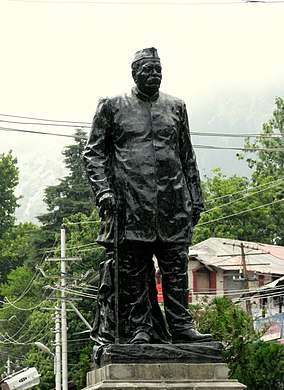 Statue of Pant at Mall Road, Nainital
Statue of Pant at Mall Road, Nainital- Statue of Pant near Sansad Bhavan, New Delhi
Family
Govind Ballabh Pant's son, Krishna Chandra Pant, was also a politician.
See also
References
- M. V. Kamath (1989). B.G. Kher, the Gentleman Premier. Bharatiya Vidya Bhavan. p. 5.
Pandit Govind Ballabh Pant was a Karhade Brahmin whose ancestors went north from Karhatak to settle in the Kumaon region
- "Govind Ballabh Pant". liveindia.com. Retrieved 8 September 2017.
- B. R. Nanda, Pant, Govind Ballabh (1887–1961), politician in India (2004)
- "Nation pays homage to Govind Ballabh Pant". The Times of India. 10 September 2006.
- "Govind Ballabh Pant Engineering College, Pauri Garhwal, Uttarakhand". Gbpec.net. Archived from the original on 25 December 2012. Retrieved 1 January 2013.
- "Padma Awards Directory (1954–2007)" (PDF). Ministry of Home Affairs. Archived from the original (PDF) on 10 April 2009. Retrieved 26 November 2010.
Further reading
- Bakshi, S. R. (1991). Govind Ballabh Pant: The True Gandhian. South Asia Books. ISBN 9788170414308.
- 18 volumes on the Selected Works of Govind Ballabh Pant authored by Dr. B. R. Nanda
External links
| Wikimedia Commons has media related to Govind Ballabh Pant. |
| Political offices | ||
|---|---|---|
| Preceded by Nawab Sir Muhammad Ahmad Said Khan Chhatari |
Chief Minister of United Provinces 17 July 1937 – 2 November 1939 |
Succeeded by Vacant |
| Preceded by Vacant |
Chief Minister of United Provinces 1 April 1946 – 25 January 1950 |
Succeeded by Post abolished United Provinces renamed to Uttar Pradesh |
| Preceded by New Creation |
Chief Minister of Uttar Pradesh 26 January 1950 – 27 December 1954 |
Succeeded by Sampurnanand |
| Preceded by Kailash Nath Katju |
Union Home Minister 10 January 1955 – 7 March 1961 |
Succeeded by Lal Bahadur Sastri |
